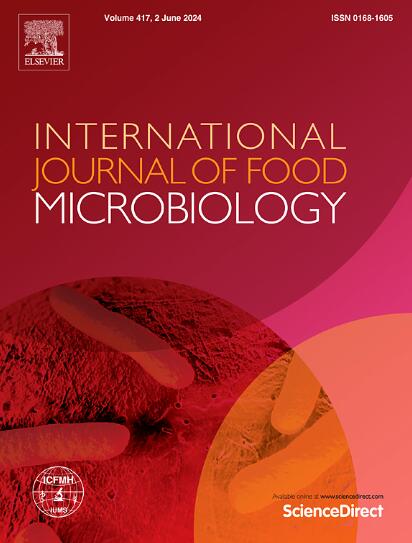Detection of Fusarium spp. and T-2 and HT-2 toxins contamination in oats using visible and near-infrared spectroscopy
IF 5
1区 农林科学
Q1 FOOD SCIENCE & TECHNOLOGY
International journal of food microbiology
Pub Date : 2025-06-04
DOI:10.1016/j.ijfoodmicro.2025.111301
引用次数: 0
Abstract
Fusarium langsethiae (FL) is one of the major contaminants in oats in the United Kingdom (UK) and is a significant producer of T-2 and HT-2 toxins, among the most prevalent mycotoxins in oats. Visible and near-infrared (Vis-NIR) (350–2500 nm) spectroscopy was explored as a non-invasive, rapid method for detecting FL, Fusarium species that produce T-2 and HT-2 toxins, and T-2 and HT-2 toxins content. Oat grains were artificially inoculated with FL and other Fusarium species under controlled water activity (aw) conditions (0.98, 0.90, and 0.80). FL was found to be particularly responsible for producing T-2 and HT-2 toxins. Classification models were developed to distinguish oat grains based on the presence of FL. The best performance was achieved with all the Vis-NIR spectra, with a classification accuracy of 76.2 %. The Vis region (350–995 nm) emerged as the most important range for classification. Additionally, oat grains were classified by T-2 and HT-2 toxin content, distinguishing oats above and below the European Union (EU) threshold with 93.3 % accuracy. For mycotoxin quantification, the best performance was obtained using the Vis region with a coefficient of determination (R2) of 0.875. Key wavelengths such as 464, 568, 575 and 636 nm were relevant for toxin detection. The NIR region (1005–1795 nm) also played a significant role in the models. This study shows that Vis-NIR spectroscopy is a promising, non-destructive tool for detecting Fusarium and type A trichothecenes in oats, though further research is needed to improve model robustness and support food safety monitoring.
可见光和近红外光谱法检测燕麦中镰刀菌及T-2和HT-2毒素污染
langsethiae镰刀菌(Fusarium langsethiae, FL)是英国燕麦中的主要污染物之一,是燕麦中最常见的真菌毒素中T-2和HT-2毒素的重要制造者。研究了可见光和近红外(Vis-NIR) (350 ~ 2500 nm)光谱作为一种无创、快速检测FL、产生T-2和HT-2毒素的镰刀菌种类以及T-2和HT-2毒素含量的方法。在控制水分活度(aw)(0.98、0.90和0.80)的条件下,用FL和其他镰刀菌对燕麦进行人工接种。发现FL特别负责产生T-2和HT-2毒素。建立了基于FL存在的燕麦颗粒分类模型,在所有可见光-近红外光谱下,分类精度达到76.2%,分类效果最佳。可见区(350-995 nm)是最重要的分类范围。此外,根据T-2和HT-2毒素含量对燕麦进行分类,区分高于和低于欧盟(EU)阈值的燕麦,准确率为93.3%。对于真菌毒素的定量,采用Vis区测定效果最佳,测定系数(R2)为0.875。关键波长为464、568、575和636 nm。近红外区域(1005 ~ 1795 nm)在模型中也发挥了重要作用。这项研究表明,Vis-NIR光谱是一种很有前途的、非破坏性的检测燕麦中镰刀菌和a型毛霉烯的工具,尽管需要进一步的研究来提高模型的鲁棒性并支持食品安全监测。
本文章由计算机程序翻译,如有差异,请以英文原文为准。
求助全文
约1分钟内获得全文
求助全文
来源期刊
CiteScore
10.40
自引率
5.60%
发文量
322
审稿时长
65 days
期刊介绍:
The International Journal of Food Microbiology publishes papers dealing with all aspects of food microbiology. Articles must present information that is novel, has high impact and interest, and is of high scientific quality. They should provide scientific or technological advancement in the specific field of interest of the journal and enhance its strong international reputation. Preliminary or confirmatory results as well as contributions not strictly related to food microbiology will not be considered for publication.

 求助内容:
求助内容: 应助结果提醒方式:
应助结果提醒方式:


